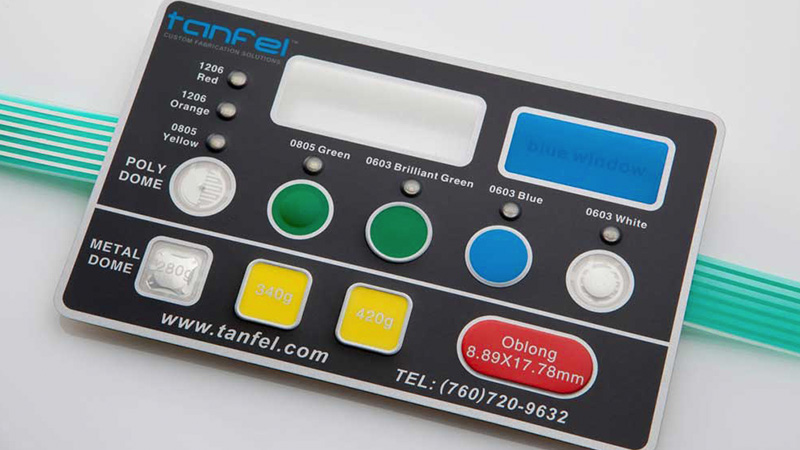How to Select the Right Membrane Switch for Your Technology Needs
How to Select the Right Membrane Switch for Your Technology Needs
Blog Article
Why Membrane Switches Over Are Important for Durable Control Systems
Membrane layer switches play an essential role in ensuring the toughness and reliability of control systems across various markets. Their special building enables them to withstand difficult environmental aspects such as moisture, temperature level extremes, and physical wear. This durability not only extends the life-span of the systems they offer but likewise decreases maintenance requirements. As we check out the multifaceted benefits of membrane switches, it comes to be evident that their importance transcends simple functionality, affecting individual experience and operational efficiency. What more effects do these characteristics hold for the future of control system style?
Summary of Membrane Buttons
Membrane layer switches are versatile and trustworthy elements generally made use of in numerous electronic control systems. The visuals overlay offers both practical and visual style, while the spacer layer makes sure that the switches are turned on just when pressed.
Membrane layer switches are usually preferred in applications requiring a small and lightweight style, making them optimal for portable gadgets, clinical equipment, and industrial machinery. They can be tailored to fulfill specific customer requirements and can integrate various functions such as backlighting, responsive responses, and multiple shades. Furthermore, membrane layer switches are resistant to dirt, moisture, and pollutants, making them appropriate for settings where resilience is vital.
Benefits of Sturdiness
In numerous applications, the resilience of membrane changes deals considerable benefits that boost their overall performance and integrity. These buttons are created to stand up to extreme settings, making them perfect for use sought after problems such as high moisture, extreme temperature levels, and direct exposure to chemicals. Their durable construction helps to prevent damage from physical effect, making sure resilient capability and minimizing the need for frequent replacements.
Furthermore, membrane layer buttons are immune to deterioration, which is vital in applications where frequent interaction takes place. This toughness equates to reduce maintenance costs, as organizations benefit from reduced downtime and fewer solution disturbances. The encapsulated design of membrane switches over shields inner parts from dust and dampness access, additional contributing to their lifespan (membrane switch).
An additional benefit is their capability to maintain regular efficiency gradually. With a high tolerance for mechanical stress, these buttons protect their tactile responses and electrical integrity, making certain individual satisfaction. Eventually, the longevity of membrane layer changes not just boosts functional efficiency however also promotes confidence in their integrity, making them a favored selection for control systems across numerous markets.
Applications in Various Industries
Long lasting control systems employing membrane layer switches find considerable applications throughout a variety of sectors, each gaining from the distinct characteristics these switches offer. In the clinical market, membrane switches are critical for tools such as client screens and diagnostic tools, where dependability and convenience of cleaning are extremely important. Their resistance to moisture and pollutants guarantees they maintain performance in clean and sterile environments.
The vehicle industry leverages membrane switches for control panel controls and infotainment systems, where they supply streamlined, low-profile interfaces that enhance individual experience. These buttons are also developed to stand up to harsh conditions, including exposure to severe temperature levels and resonances.
In industrial settings, membrane switches are generally used in machinery control panels, using responsive comments and sturdiness required for high-usage applications. Their capability to withstand chemicals makes them suitable for producing atmospheres where spills and pollutants are constant.

Consumer electronics, such helpful hints as kitchen appliances and push-button controls, additionally use membrane buttons for their adaptability and cost-effectiveness. In general, the flexibility and durable nature of membrane switches make them essential across various sectors, ensuring reliable procedure and durability in control systems.
Style and Aesthetic Charm
While functionality is vital, the design and visual charm of control systems outfitted with membrane layer buttons play a critical role in customer interaction and general experience (membrane switch). The aesthetic design of these buttons can considerably affect customer perception and interaction. A well-designed membrane layer switch enhances the good looks of the gadget, making it more enticing to users and fostering a link between the customer and the product
Membrane switches over provide a good deal of versatility in design, allowing makers to personalize graphics, colors, and textures to line up with brand identification and product appearances. Using vibrant shades and distinctive patterns can draw interest, while tactile feedback can reinforce the user's communication with the device. Furthermore, the capacity to integrate LED indications and backlighting into the membrane layer switch style gives both practical and visual benefits, improving presence and use in various atmospheres.

Enhancing Customer Experience

Furthermore, membrane switches can be customized to integrate graphical interfaces, enhancing usability by presenting details in a clear and instinctive fashion (membrane switch). This modification can consist of symbols, tags, and color coding that guide users via facility capabilities easily. In addition, their adaptability enables combination in various environments, ensuring regular efficiency whether in industrial machinery or customer electronics
The durability of membrane More about the author layer buttons likewise plays a vital role in customer experience. By holding up against extreme conditions and expanded usage, these switches reduce the possibility of system failings, hence promoting dependability and individual confidence. Eventually, the critical use membrane switches over not only elevates capability yet also considerably enhances customer interaction with control systems, making them an try these out essential part in contemporary design.
Final Thought

Report this page